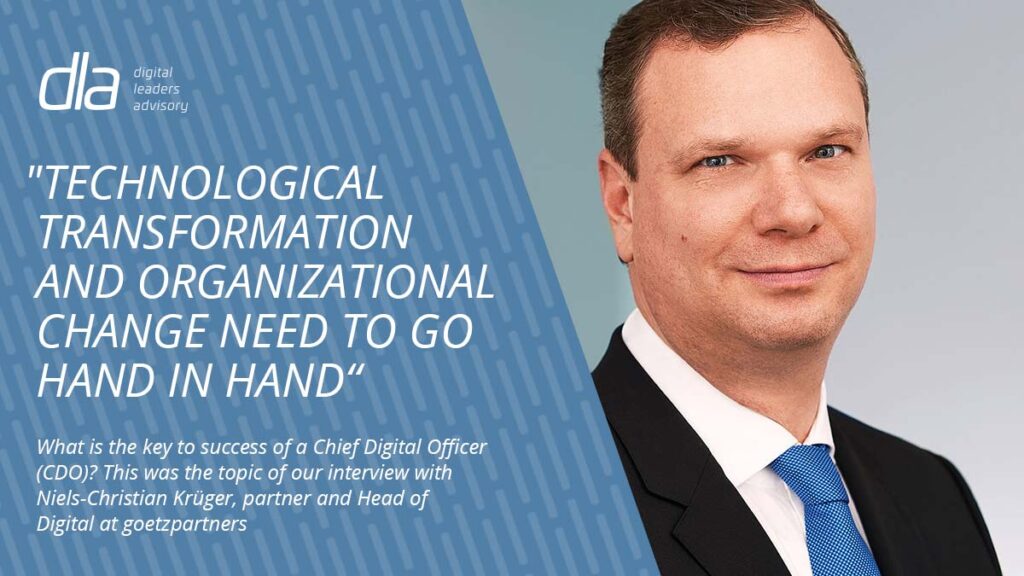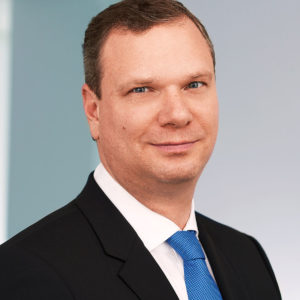
dla: Mr Krüger, is a Chief Digital Officer only as good as the extent to which he makes himself superfluous?
Niels-Christian Krüger: A CDO has one core task above all: he has to make the company more productive and, in doing so, give it an even better chance of survival. The special challenge lies in the speed with which this task has to be realized today, a speed that is multiple times greater than an organization’s ability to adapt. To keep pace, the CDO has to make the organization agile and willing to embrace change.
Part of this is essentially also that the scope of his own contribution to a specific project or a certain phase in a company’s development can be limited. After two, three or five years, this results in another new angle on things and introduces new competences into the organization that are then decisive for productivity. The word “superfluous” is not applicable to a manager of this kind anyway. In the future, we will be seeing CDOs whose careers more frequently take them to the top of the company. A growing number of companies need CEOs with digital DNA and management experience in the digital environment.
dla: What areas are companies focusing on today in recruiting their CDOs?
Niels-Christian Krüger: In Germany, I am currently essentially seeing three types of CDOs: firstly, the internal “climber” from the technological divisions of an organization, especially the CIO or CTO. Secondly, as a counterpart, the “surprise candidate”, meaning someone outside the company, often from a completely different business or even a different sector who contributes their experience as a manager of complex change processes. The third type, however, is in particularly high demand, namely the “rising star”. These are managers who, prior to taking their CDO career step, have worked in companies with a strong digital DNA, whether for a start-up, an agency or another digital disruptor.
dla: So the rising star comes from a completely different kind of company in cultural and structural terms. Is this kind of person able to make the transition to the world of large corporates? Does he speak their language?
Niels-Christian Krüger: In the first instance, his background must suit the business model and the company’s goals. A CDO with a curriculum vitae from an agency business can, for example, drive digitalization in the direction of marketing as well as internal and external communication in particular. Managers from start-ups and from platform providers are generally in huge demand due to their technological skills.
The most important challenge with the rising star is essentially quite different: how do they manage to compensate for their lack of experience in the structures and processes, as well as deficiencies in the language of organizations? Naturally, the aforementioned assignment to specific areas such as IT or marketing also harbors a danger of only being heard in this area and not throughout the entire organization. This is, however, precisely one of the core tasks of a CDO, namely to develop and realize an architecture and a road map towards digitalizing the entire company.

dla: The success of a CDO is ultimately not measured by his innovative ideas but by the impact that his initiatives have on the organization. How can one ensure that the work of a CDO will not fail to deliver?
Niels-Christian Krüger: Technological transformation and organizational change need to go hand in hand. If a CDO achieves this harmonization, he will have an impact. At the present point in time, many companies are concentrating on keeping up with technological dimensions. This is difficult, if not impossible. Innovations in artificial intelligence, virtual reality, platform architectures and in many other areas are taking place at a speed that is entirely different from the pace at which most organizational structures develop.
As a CDO, I therefore have to do a great deal more than ensuring that each department head gets a smart phone with high-end tools, for instance. It is much more important to select such tools in line with the existing competences and then also to ensure that they develop with and for the organization in the future. Only then will a company find itself on a sustainable course heading toward digitalization.
dla: What role does the digital maturity ascertained by the CTO in the company play?
Niels-Christian Krüger: Naturally, the work of a CDO will be easier or more difficult depending on what he is confronted with. There are companies in which the much vaunted disruption has been part of everyday life for 15 to 20 years, such as in the retail business or in the media and entertainment industry. Other companies, such as those in the financial and insurance sector, have only been feeling the pressure to change quite recently. There are naturally also organizations that need to be successful in raising their productivity in the competitive arena rather than being disruptive in the sense of new customers and business models.
dla: A CDO must therefore adapt to this individual set of circumstances and market conditions …
Niels-Christian Krüger: Precisely. There is one question above all that he needs to ask: How do I embed new technologies and practices in the cultural and structural context of my company in a targeted way? Time and time again I notice that CDOs are especially successful if they specifically direct the focus on innovation strength and technologically practical curiosity, which is an aspect so typical of the German industry – and if they do this across all hierarchical levels. If one engages here, sustainable impact can be achieved, and this very quickly.
dla: How quickly does a transformation of this kind take place?
Niels-Christian Krüger: When implementing most technologies, a time window of 18 to 36 months is realistic depending on the size of the company and the willingness of line staff to actively support the change processes described. A new technology does not in itself guarantee a swift pace: Cloud solutions can deliver initial success, for example. At the same time, however, adjusting the legacy IT must be ensured, a process which requires a somewhat longer time horizon and partly entails models such as shadow IT and two-speed IT. It is not speed, but prudence that is the key success factor here.
dla: IT is of course only one dimension. What goes on at the organizational level?
Niels-Christian Krüger: Similarly, different development speeds are generally the rule of thumb here. Incentives need to be created to ease staff quickly into new working methods through a programmatic approach. At the same time, a strategic plan outlining the long-term digital transformation of the organization needs to be defined.
Technology works here as an enabler and as the prerequisite for topics such as collaboration and achieving efficiency gains. The aim always has to be ensuring that the company is the one best prepared for digital transformation in its line of business. Essentially, this means raising productivity through technology and organizational transformation and sharpening a company’s competitive edge.
Interviewpartner

Niels-Christian Krüger is a partner and Head of Digital at goetzpartners and advises especially on the topics of digitalization, innovation and transformation.
As an author, he regularly publishes articles, for example on “The Demystification of Digital”, “The Digital CEO” and “How to turn your employees into digital partners”. He was the founder of the “Digital Strategy Day”, an exclusive event series in New York.
Prior to joining goetzpartners, Niels-Christian Krüger worked at Google Cloud in London, Madrid and Sydney for several years.
